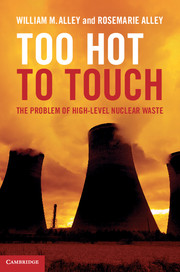Book contents
- Frontmatter
- Contents
- Acknowledgments
- List of units
- List of abbreviations
- Introduction
- Part I The problem
- Part II The mountain
- 12 The search for a geologic repository
- 13 Nevada wins the lottery
- 14 The Nevada Test Site
- 15 Yucca Mountain
- 16 How long is long?
- 17 Leaving almost no stone unturned
- 18 Surprise
- 19 Shake & bake
- 20 The project gets into hot water
- Part III No solution in sight
- Appendix Discussion questions
- References
- Index
17 - Leaving almost no stone unturned
from Part II - The mountain
Published online by Cambridge University Press: 05 February 2013
- Frontmatter
- Contents
- Acknowledgments
- List of units
- List of abbreviations
- Introduction
- Part I The problem
- Part II The mountain
- 12 The search for a geologic repository
- 13 Nevada wins the lottery
- 14 The Nevada Test Site
- 15 Yucca Mountain
- 16 How long is long?
- 17 Leaving almost no stone unturned
- 18 Surprise
- 19 Shake & bake
- 20 The project gets into hot water
- Part III No solution in sight
- Appendix Discussion questions
- References
- Index
Summary
You never feel quite as comfortable about a site
as the day you start to study it.
Wendell WeartOn June 4, 2008, at 8:40 a.m., a moving truck pulled up to the Nuclear Regulatory Commission and dropped off 15 sets of the Department of Energy's license application to construct a nuclear waste repository at Yucca Mountain. Each set weighed 110 pounds (50 kg) and totaled 8,600 pages. It was more than a quarter-century since work began at Yucca Mountain and a decade after the federal government had promised the nuclear industry an operational repository for their wastes. This delivery marked an important milestone, yet it would be at least another decade until the repository opened – perhaps never, if Nevada had its way.
Comprising hundreds of studies, the license application was the most complex application ever completed. Never before had mere mortals been assigned the task of making scientific predictions spanning such geologic timeframes.
total system performance assessment
A good part of the case presented to the NRC was based on a Total System Performance Assessment, or TSPA. Using a series of linked computer models, the TSPA strove to provide quantitative answers to three basic questions: What might happen in the future to the waste? How likely are different scenarios? What are their consequences? The TSPA was the grail of this difficult and extended quest. The effort was led by Sandia National Laboratories, world leaders in performance assessment.
- Type
- Chapter
- Information
- Too Hot to TouchThe Problem of High-Level Nuclear Waste, pp. 251 - 271Publisher: Cambridge University PressPrint publication year: 2012



